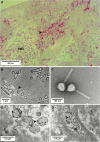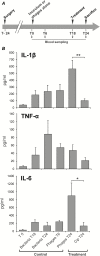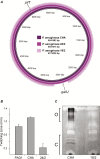Synergistic Interaction Between Phage Therapy and Antibiotics Clears Pseudomonas Aeruginosa Infection in Endocarditis and Reduces Virulence
- PMID: 28007922
- PMCID: PMC5388299
- DOI: 10.1093/infdis/jiw632
Synergistic Interaction Between Phage Therapy and Antibiotics Clears Pseudomonas Aeruginosa Infection in Endocarditis and Reduces Virulence
Abstract
Background: Increasing antibiotic resistance warrants therapeutic alternatives. Here we investigated the efficacy of bacteriophage-therapy (phage) alone or combined with antibiotics against experimental endocarditis (EE) due to Pseudomonas aeruginosa, an archetype of difficult-to-treat infection.
Methods: In vitro fibrin clots and rats with aortic EE were treated with an antipseudomonas phage cocktail alone or combined with ciprofloxacin. Phage pharmacology, therapeutic efficacy, and resistance were determined.
Results: In vitro, single-dose phage therapy killed 7 log colony-forming units (CFUs)/g of fibrin clots in 6 hours. Phage-resistant mutants regrew after 24 hours but were prevented by combination with ciprofloxacin (2.5 × minimum inhibitory concentration). In vivo, single-dose phage therapy killed 2.5 log CFUs/g of vegetations in 6 hours (P < .001 vs untreated controls) and was comparable with ciprofloxacin monotherapy. Moreover, phage/ciprofloxacin combinations were highly synergistic, killing >6 log CFUs/g of vegetations in 6 hours and successfully treating 64% (n = 7/11) of rats. Phage-resistant mutants emerged in vitro but not in vivo, most likely because resistant mutations affected bacterial surface determinants important for infectivity (eg, the pilT and galU genes involved in pilus motility and LPS formation).
Conclusions: Single-dose phage therapy was active against P. aeruginosa EE and highly synergistic with ciprofloxacin. Phage-resistant mutants had impaired infectivity. Phage-therapy alone or combined with antibiotics merits further clinical consideration.
Keywords: Pseudomonas aeruginosa; bacteriophage; endocarditis; phage therapy; resistance; antibiotic.
© The Author 2016. Published by Oxford University Press for the Infectious Diseases Society of America.
Figures







Comment in
-
Phages, Fitness, Virulence, and Synergy: A Novel Approach for the Therapy of Infections Caused by Pseudomonas aeruginosa.J Infect Dis. 2017 Mar 1;215(5):668-670. doi: 10.1093/infdis/jiw634. J Infect Dis. 2017. PMID: 28007923 No abstract available.
References
-
- Chanishvili N. Phage therapy—history from Twort and d’Herelle through Soviet experience to current approaches. Adv Virus Res 2012; 83:3–40. - PubMed
-
- Lang G, Kehr P, Mathevon H, Clavert JM, Séjourne P, Pointu J. Bacteriophage therapy of septic complications of orthopaedic surgery. Rev Chir Orthop Reparatrice Appar Mot 1979; 65:33–7. - PubMed
-
- Speck P, Smithyman A. Safety and efficacy of phage therapy via the intravenous route. FEMS Microbiol Lett 2016; 363. - PubMed
-
- Chhibber S, Kaur S, Kumari S. Therapeutic potential of bacteriophage in treating Klebsiella pneumoniae B5055-mediated lobar pneumonia in mice. J Med Microbiol 2008; 57:1508–13. - PubMed
MeSH terms
Substances
LinkOut - more resources
Full Text Sources
Other Literature Sources
Medical

